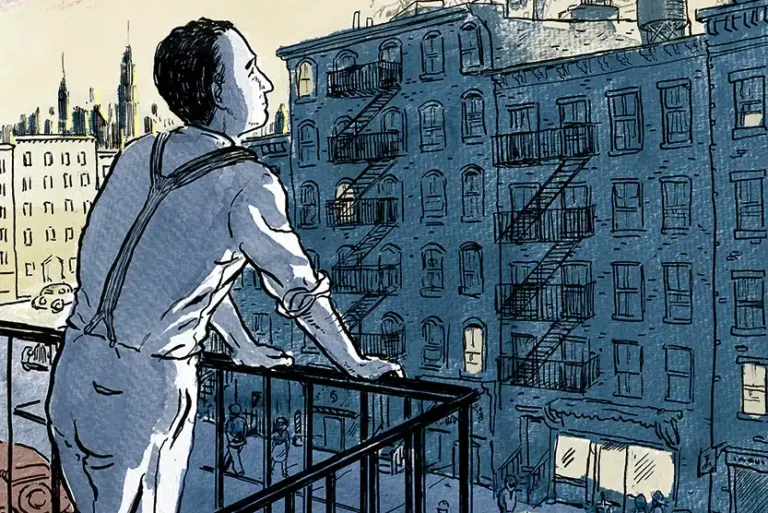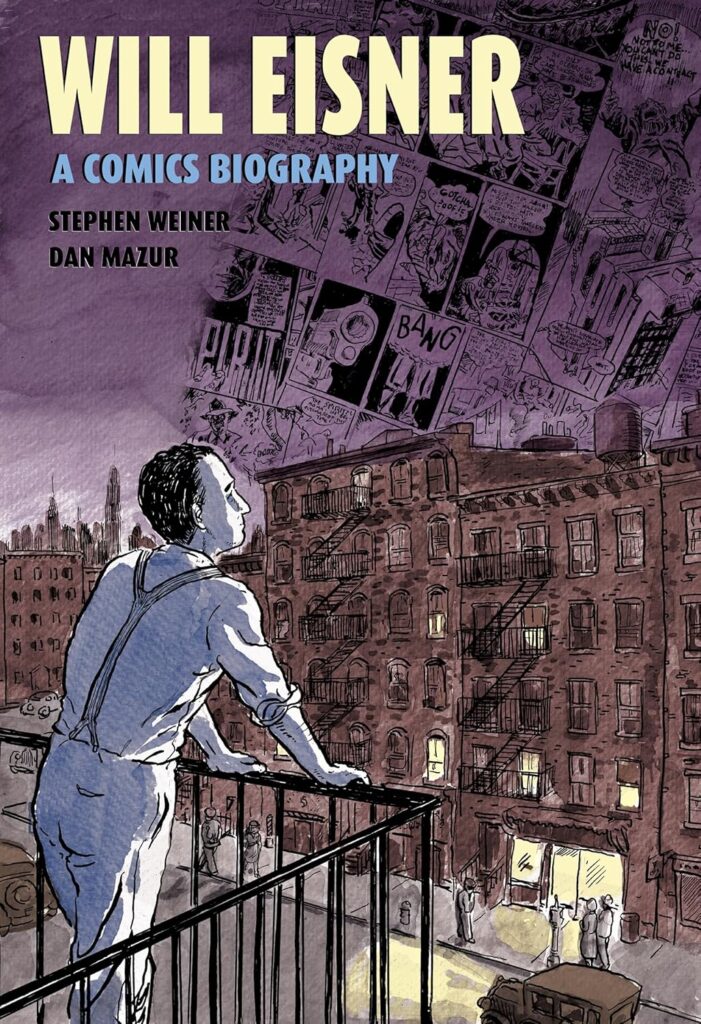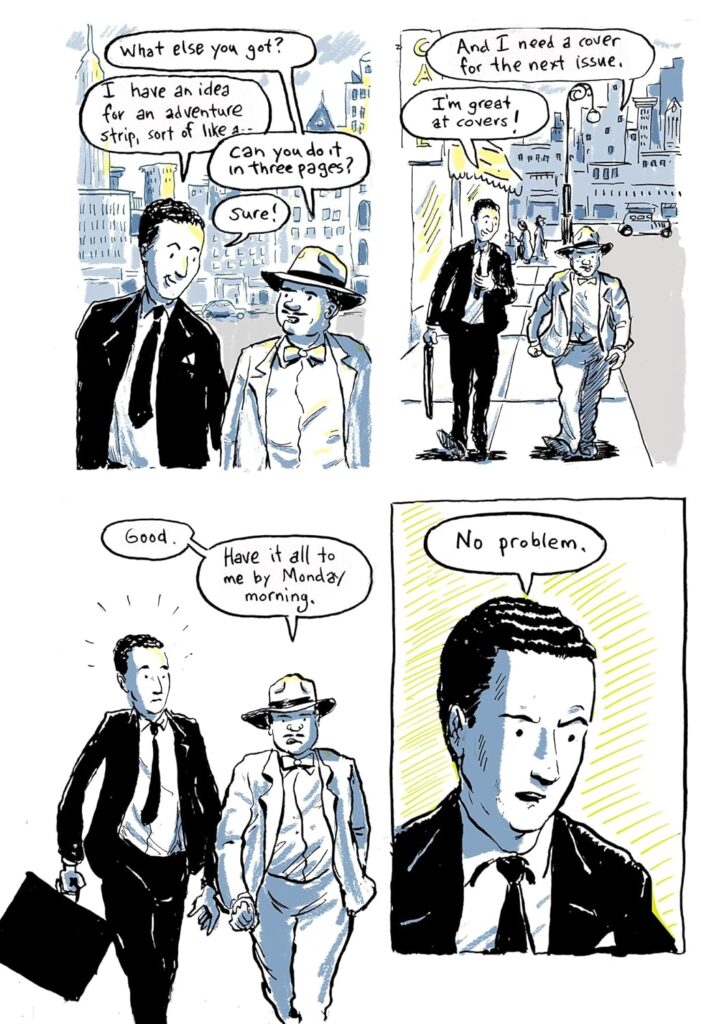
Long before graphic novels lined bestseller lists and earned literary accolades, Will Eisner pioneered the form, treating comics not as pulp but as art. Now, a new biography in panels tells his story the way he told so many others — through ink and imagination.
“Will Eisner: A Comics Biography,” the new graphic novel by Boston-based artist Dan Mazur and writer Stephen Weiner, traces the Jewish writer’s life from his early days hustling in Depression-era New York to his groundbreaking work on his groundbreaking graphic novel “The Spirit,” and his later reinvention of comics as a literary form.
Told in sharp, evocative panels, the book mirrors the very storytelling techniques Eisner helped invent: cinematic pacing, emotional depth, and a respect for the graphic novel reader’s intelligence.

It’s a fitting tribute to a figure who is credited with creating the medium — and one Mazur and Weiner say deserves even more recognition.
“Will Eisner was one of the most influential cartoonists in the history of American comics,” Mazur told Unpacked.
“Eisner basically created the storytelling language of the American comic book,” Weiner added.
Eisner’s contributions to the comic book form are well documented, but what’s sometimes overlooked is how deeply his Jewish identity shaped his work. As Mazur and Weiner explain in the biography, Eisner didn’t just pioneer a new visual language; he used it to explore themes of diaspora, resilience, assimilation, and faith.
Will Eisner’s Jewish background
Raised in Brooklyn during the Great Depression, William Erwin Eisner grew up in a working-class Jewish family and faced both poverty and antisemitism from a young age — experiences that would later shape the emotional depth of his storytelling. Eisner learned early on how to stick up for himself, both personally and professionally.
“Almost all the early comic book creators were Jewish,” Weiner explained, “and Eisner is one of the most prominent.”
While he was an early advocate of comics, Eisner first made his mark in the book packaging industry, selling illustrated stories to publishers in the early days of the comic book boom. Soon, he began to innovate not just with content, but with format, finding new ways to tell stories with pictures. His big break came with a tabloid-sized comic called “The Spirit,” a masked crime-fighter insert distributed in Sunday newspapers from June 2, 1940, to Oct. 5, 1952. In its pages, the vigilante Denny Coyle (The Spirit) battled criminals in urban back alleys, shadowy hideouts — and, in one memorable story, on the moon.
“I first became aware of Eisner in my 20s,” Weiner recalled, “thanks to…reprints of The Spirit.”
Not only did “The Spirit” launch Eisner’s career; it also launched that of famed illustrator and artist Jules Feiffer, who began working for Eisner as a teenager. Feiffer famously insisted that the titular character was, in fact, Jewish, despite his “goyish” name and appearance.
“Feiffer says that all the people working on ‘The Spirit’ thought that he was Jewish,” Mazur said.
When asked directly about Eisner’s Judaism, Mazur suggested that while he was raised in an Orthodox household, Eisner was “always pretty much a secular guy” and became more “Jew-ish” as he got older. Weiner points to “A Contract with God” — widely considered the first modern graphic novel — as a pivotal example. The book, published in 1978, centers on the sorrows of a Jewish tenement community in the Bronx. Eisner’s final major work was “The Plot,” which tackled the notorious antisemitic hoax “Protocols of the Elders of Zion.”
“Jewishness isn’t a huge part of this story,” Mazur said, “but it’s sort of ever-present in the background, and I really came to see that this is very much a Jewish story and should be presented as such.”
Will Eisner’s legendary comics career
Like so many Jewish artists of his generation, Eisner turned to comics after he was shut out of employment in more “serious” creative fields such as advertising. At the time, institutional antisemitism often limited opportunities for Jewish illustrators and writers in mainstream media.
“Comic books were a new — and despised — form,” Mazur said, describing them as “a ghetto” for Jewish talent.
But the fledgling comic book industry became a proving ground for a young Eisner. He was not only able to rise through its ranks, but also elevate comics to national prominence. Today, the most prestigious honor in the industry bears his name: the Will Eisner Comic Industry Awards.
“The award is named after Eisner because of his enormous contribution to the field,” Weiner explained.
“It says a lot that they chose Will Eisner as the one person to name the award after,” Mazur added.

Weiner, who has been at the forefront of the graphic novel movement for decades, was a natural choice to help bring Eisner’s story to life. He previously co-authored “The Will Eisner Companion” (with N.C. Christopher Couch) and wrote “Will the Real Will Eisner Please Stand Up? & Other Adventures in Comics.” His book “Faster than a Speeding Bullet: The Rise of the Graphic Novel” even includes an introduction written by Eisner himself.
Mazur, too, brings deep expertise and passion to the project. In addition to his own comics appearing in numerous anthologies, he co-authored “Comics: A Global History, 1968 to the Present” — a book now translated into seven languages — and co-founded the Massachusetts Independent Comics Expo (MICE) and the Boston Comics Roundtable.
For Weiner and Mazur, comics are not just a medium but a dynamic fusion of multiple art forms.
“Comics are their own art form,” he said, “but they also evoke or include other forms.”
Comics, he added, “involve…the reader in both looking at pictures and moving through a series of pictures that have been arranged to tell a story,” and so recall and build upon both visual art and movies.
Both of the authors’ connections to comics also run deep. Mazur grew up in a household steeped in creativity — his father was an artist — so making art was “encouraged” from a young age and naturally became a lifelong pursuit.

Weiner races his comic book awakening after receiving a pile of comics as a Hanukkah present from his older brother. He was particularly struck as a teenager by “The Spirit,” which shaped his understanding of what comics could aspire to be.
“Eisner’s work contributed to my overall idea of what comics could be,” Weiner explained, noting that working on “Will Eisner: A Comics Biography” made him feel like Eisner in that it required him to “reinvent” himself as a creator, as the legendary writer so often did.
Eisner’s influence was well documented after he died in 2005. Mazur and Weiner acknowledge that their biography is far from the first book to chronicle his life; however, theirs is different in a significant way.
“There are [at least] four biographies of Eisner,” Weiner noted, “This is the first biography in the graphic novel format that Eisner helped create.”
“I don’t know if it’s an irony,” Mazur added, “but it definitely makes me a little nervous to think our work in the same medium might be compared to one of the all-time greats. Hopefully, readers won’t hold us to quite too high a standard.”
Originally Published Jun 23, 2025 09:40AM EDT













